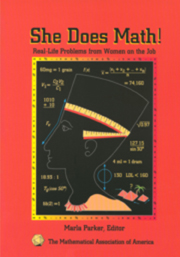Book contents
- Frontmatter
- Preface
- Contents
- Problems by Subject
- Environmental Psychology
- Software Engineering; Computer Science
- Archaeology
- Mathematics and Computer Science
- Civil Engineering
- Mathematics
- Electrical Engineering
- Physics; X-ray Astronomy Research
- Mathematics
- Physics; Astronaut Crew Training Instructor
- Business Data Processing
- Software Engineering; Real Estate Investment
- Quality Engineering
- Health Science
- Nursing Education
- Electrical Engineering; Space Systems
- Oil and Gas Accounting
- Business Administration Higher Education
- Aerospace Engineering
- Structural Engineering
- Computer Science
- Mathematics
- Dietetics—Foodservice Management and Nutrition
- Electrical Engineering
- Chemical Engineering, retired
- Software Engineering
- Immunology and Microbiology
- Mechanical Engineering
- HMO Pharmacy Practice and Management
- Ophthalmology
- Electrical Engineering
- Fish Pathology
- Computer Science and Computer Graphics
- Mathematics and Computing
- Electrical Engineering
- Astronomy
- Author
- Mathematics
- Reflections on WAM
- Solutions
Business Administration Higher Education
- Frontmatter
- Preface
- Contents
- Problems by Subject
- Environmental Psychology
- Software Engineering; Computer Science
- Archaeology
- Mathematics and Computer Science
- Civil Engineering
- Mathematics
- Electrical Engineering
- Physics; X-ray Astronomy Research
- Mathematics
- Physics; Astronaut Crew Training Instructor
- Business Data Processing
- Software Engineering; Real Estate Investment
- Quality Engineering
- Health Science
- Nursing Education
- Electrical Engineering; Space Systems
- Oil and Gas Accounting
- Business Administration Higher Education
- Aerospace Engineering
- Structural Engineering
- Computer Science
- Mathematics
- Dietetics—Foodservice Management and Nutrition
- Electrical Engineering
- Chemical Engineering, retired
- Software Engineering
- Immunology and Microbiology
- Mechanical Engineering
- HMO Pharmacy Practice and Management
- Ophthalmology
- Electrical Engineering
- Fish Pathology
- Computer Science and Computer Graphics
- Mathematics and Computing
- Electrical Engineering
- Astronomy
- Author
- Mathematics
- Reflections on WAM
- Solutions
Summary
Mathematics always made me feel successful. My grade school was very small, less than 250 students, with more girls than boys in all of my classes. All of my teachers were women, and girls were always the top performers in math.
As time went on, I attended an all-girl high school and took all the math courses that were offered to college-bound students, including calculus during my senior year. All my math teachers were very serious and dedicated women. I specifically remember my geometry and algebra teachers, who made the material very easy to understand.
Following high school, I attended a co-ed liberal arts college. In my freshman and sophomore years, I fell in love with art, music, and literature, and filled my schedule with these new interests. But in my junior year, I gravitated back to math, taking a calculus course. For the first time in my life, the teacher at the front of the class was a man. Also for the first time, I was outnumbered by the men in the class. But that didn't matter. I still enjoyed the work and was successful at it.
My junior and senior years as a psychology major required specific courses including statistics, research design, and logic. Newly-offered computer science courses attracted me, so I enrolled in an introductory course that focused on machine language. The professor held a doctorate in computer science and was my first non-liberal arts woman professor.
- Type
- Chapter
- Information
- She Does Math!Real-Life Problems from Women on the Job, pp. 65 - 67Publisher: Mathematical Association of AmericaPrint publication year: 1995



